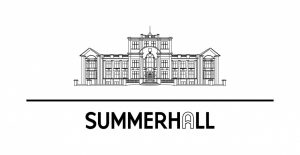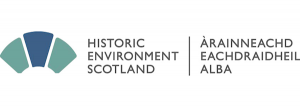At Summerhall: Visible Girls: Revisited and Invisible Spaces*****
What makes a space invisible? Perhaps it is behind a door, on the other side of a wall, or even under the sea. Perhaps it is in plain sight, a place that is so familiar and ordinary to us that we no longer see it at all. Or perhaps it doesn’t even exist – we have imagined it or created it within ourselves.
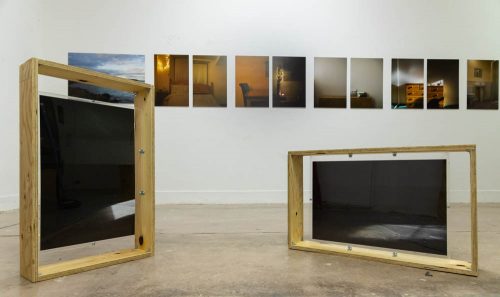 In Scotland’s Year of Young People, Neil Gregory and Andrew James of Historic Environment Scotland have been working with a diverse group of 18-26 year olds, encouraging them to tell the story of the places they inhabit, places that are special to them. From an armchair to a suitcase, a deserted supermarket car park to a Glaswegian nightclub, the 29 participants in this project have explored the meaning of space and place, and considered them in relation to their own sense of identity in today’s Scotland. Now their work has been brought together in Invisible Spaces, an exceptional new exhibition at Summerhall.
In Scotland’s Year of Young People, Neil Gregory and Andrew James of Historic Environment Scotland have been working with a diverse group of 18-26 year olds, encouraging them to tell the story of the places they inhabit, places that are special to them. From an armchair to a suitcase, a deserted supermarket car park to a Glaswegian nightclub, the 29 participants in this project have explored the meaning of space and place, and considered them in relation to their own sense of identity in today’s Scotland. Now their work has been brought together in Invisible Spaces, an exceptional new exhibition at Summerhall.
Pooja Suresh’s interest is in everyday spaces; pubs, street corners, takeaways. It is in these, she says that we become personally invested, rather than huge monuments or famous houses. The space that matters most to Pooja is her small Edinburgh flat. It is, she 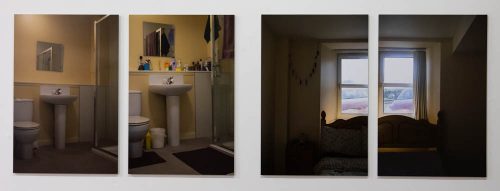 explains, a place of two identities – the one she wants to show to others, and the one others see. It is also her sanctuary, a place to which she can retreat, and ‘there is always a cup of tea somewhere.’ Pooja’s dual photograph of her bathroom devoid of any personal possessions then full of bottles, tubes and towels illustrates the way in which she has brought her identity to a simple space.
explains, a place of two identities – the one she wants to show to others, and the one others see. It is also her sanctuary, a place to which she can retreat, and ‘there is always a cup of tea somewhere.’ Pooja’s dual photograph of her bathroom devoid of any personal possessions then full of bottles, tubes and towels illustrates the way in which she has brought her identity to a simple space.
 Another everyday space is explored in Kathryn Kerr’s lovely montage of her granny’s flat in Gorgie. An armchair, a teacup, a bag of chocolate caramels; they could belong to any granny, but Kathryn has filled her space with special memories – family photos, a quilt made by her granny and her mum, music that her granny loved. Kathryn’s own photographs record the sights of Gorgie; the Tynecastle Arms, the Caledonian Brewery, Gorgie Dalry Church, and the star of her show, a beautiful bejewelled dragonfly that decorated her granny’s garden.
Another everyday space is explored in Kathryn Kerr’s lovely montage of her granny’s flat in Gorgie. An armchair, a teacup, a bag of chocolate caramels; they could belong to any granny, but Kathryn has filled her space with special memories – family photos, a quilt made by her granny and her mum, music that her granny loved. Kathryn’s own photographs record the sights of Gorgie; the Tynecastle Arms, the Caledonian Brewery, Gorgie Dalry Church, and the star of her show, a beautiful bejewelled dragonfly that decorated her granny’s garden.
 Natalie Whitehill also explores what makes places so influential for us, but her videos are far from cosy. They show an empty underground car park, its fluorescent lights constantly flickering, its only occupant an abandoned supermarket trolley. In its own way, this is a special place – though we’d never think of it as ‘important’, we recognise it instantly; we’ve all been there.
Natalie Whitehill also explores what makes places so influential for us, but her videos are far from cosy. They show an empty underground car park, its fluorescent lights constantly flickering, its only occupant an abandoned supermarket trolley. In its own way, this is a special place – though we’d never think of it as ‘important’, we recognise it instantly; we’ve all been there.
Spaces also form part of our cultural identity. Inzajeano Latif’s images of Govanhill look at what it is to be an Asian in Scotland today, while Khadea Kuchenmeister makes clever use of text montage to consider her own identity as the child of two different cultural parents, one German, one Senegalese. Montage, she says, helps her to make sense of a sometimes confusing world.
 Some people have no place to call home. Yanze Wang’s art is about transience. She has moved so often throughout her life that she feels she has never put down roots;
Some people have no place to call home. Yanze Wang’s art is about transience. She has moved so often throughout her life that she feels she has never put down roots;
‘there is no permanent home for me. But as time goes by I learn to enjoy being alone.’
One of Yanze’s delicate illustrations shows a girl standing on a suitcase, her head obscured by clouds.
Chema Rodríguez Alcántara has approached the idea of invisible spaces from another angle, photographing the possessions of rough sleepers, the homeless people who are so often invisible to the rest of us, whose spaces are the ones no-one else wants; their blankets, sleeping bags and clothes are left on park benches and doorways in backstreets. He believes that art should be;
‘A powerful conversation, a call to action and a political statement.’
One striking image seems to show only the lower part of a torso; it is of a man slouched against a wall, his top half hidden behind it. Chema has displayed his work on boards that might be used to construct a makeshift shelter.
Several contributors examine the concept of beauty, of the things we do to that most personal of space, our own bodies. Madeleine Kaye’s tiny sculptures are of false nails and  eyelashes; seen out of context they are strange, sometimes macabre objects with lives of their own. A fractured porcelain face mask points up the ways in which we seek (not always successfully) to manipulate our own image. Photographs of beauty salons and a barber’s shop reflect the intimacy of these everyday settings. Artist, activist and curator Natasha Ruwona’s images look at black culture in the beauty world; her images of African salons show exotic hairstyles and ethnic hair products. She shows the salons closed to highlight the distance between herself and the African side of her identity. A researcher with Edinburgh University’s student-based decolonising project UncoverED, Natasha seeks to highlight the spaces that symbolise People of Colour in a city that is so overwhelmingly represented as white.
eyelashes; seen out of context they are strange, sometimes macabre objects with lives of their own. A fractured porcelain face mask points up the ways in which we seek (not always successfully) to manipulate our own image. Photographs of beauty salons and a barber’s shop reflect the intimacy of these everyday settings. Artist, activist and curator Natasha Ruwona’s images look at black culture in the beauty world; her images of African salons show exotic hairstyles and ethnic hair products. She shows the salons closed to highlight the distance between herself and the African side of her identity. A researcher with Edinburgh University’s student-based decolonising project UncoverED, Natasha seeks to highlight the spaces that symbolise People of Colour in a city that is so overwhelmingly represented as white.
 Some artists customise spaces in their own idiosyncratic way. Kris Whyte’s atmospheric black and white photographs of railway lines, underpasses and walls show the nocturnal world of graffiti artists. A hooded figure stands on a roof, another leans from a ladder; Kris says his interest is in ‘the process rather than the finished article’, the artists themselves rather than the art they create.
Some artists customise spaces in their own idiosyncratic way. Kris Whyte’s atmospheric black and white photographs of railway lines, underpasses and walls show the nocturnal world of graffiti artists. A hooded figure stands on a roof, another leans from a ladder; Kris says his interest is in ‘the process rather than the finished article’, the artists themselves rather than the art they create.
Lauren Deeth-Kelt’s fascinating pictures of Victorian divers explore quite another idea of invisibility. Despite having been an Edinburgh art history student, Lauren says she didn’t discover much about the real culture of Scotland until she took up SCUBA diving. Having 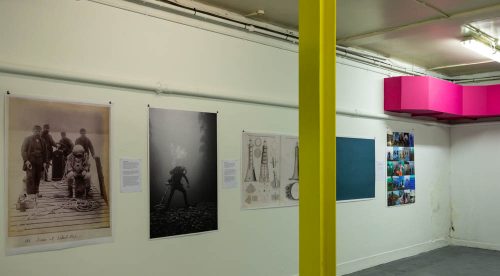 moved away from home, she wanted to find a new sense of community, and in the diving community she found just that; it became her own eccentric space.
moved away from home, she wanted to find a new sense of community, and in the diving community she found just that; it became her own eccentric space.
The many shipwrecks to be found in Scottish waters are also invisible to most of us. Historic Environment Scotland protects them; they are largely secret places, seen only by fish – and divers. Lauren has found many clues to our maritime archaeology in The National Record of the Historic Environment and the Drs Paula and Colin Martin Collection. She shows lighthouse plans and beacons alongisde photos of her diving friends today.
History may be invisible for many reasons. Hannah Campbell and Zoe Charlery’s project Sacred to the memory of… focuses on Edinburgh statues. There are plenty of them, but very few are of women and only one represents a person of colour. Hannah and Zoe use photomontage to examine Scotland’s complicity with the slave trade, an ‘erased history’ that they want to uncover; they invite viewers to look more closely at their contradictory compositions to see what is right in front of them.
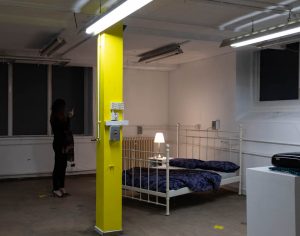 In Lauren Evans’ installation we see a bed and a side table. The bed is both a safe space and an unsafe one. It is the place to which Lauren retreats when she is overcome by suicidal thoughts, but it’s also a place where depressing feelings can spiral. The drawer of her table is open, showing empty packets of medication; a duvet has been carefully embroidered with destructive, sad phrases ‘Stupid lazy me’, ‘My future is bleak.’. The duvet is crumpled and tossed carelessly onto the bed.
In Lauren Evans’ installation we see a bed and a side table. The bed is both a safe space and an unsafe one. It is the place to which Lauren retreats when she is overcome by suicidal thoughts, but it’s also a place where depressing feelings can spiral. The drawer of her table is open, showing empty packets of medication; a duvet has been carefully embroidered with destructive, sad phrases ‘Stupid lazy me’, ‘My future is bleak.’. The duvet is crumpled and tossed carelessly onto the bed.
Charlotte Liddell has also experienced mental health problems. A mother of two small sons and a kinship carer, Charlotte says she had ‘never been an artist’ – but for the past year she has been a mentee of Scotland’s First Minister, Nicola Sturgeon, who has encouraged her to believe in herself and her own ideas. Here Charlotte shows photographs of places she takes her children to play, to exercise their ‘innocent imaginations’, but alongside these she has installed a wardrobe, a closed box splashed with red; she invites us to enter, and to listen to the soundtrack of her anxiety.
 Invisible Spaces runs alongside Visible Girls Revisited, the exhibition that first inspired it. In 1981 photographer Anita Corbin developed a photo series in which she focused on pairs of young women in London subcultures; punks, skinheads, mods…they’re all there. Some were friends, some sisters, some lovers. In their own way each one defied the mainstream; their expressions challenge the viewer as they challenged the cultural norms of the day.
Invisible Spaces runs alongside Visible Girls Revisited, the exhibition that first inspired it. In 1981 photographer Anita Corbin developed a photo series in which she focused on pairs of young women in London subcultures; punks, skinheads, mods…they’re all there. Some were friends, some sisters, some lovers. In their own way each one defied the mainstream; their expressions challenge the viewer as they challenged the cultural norms of the day.
Visible Girls toured the country to great acclaim, and 37 years later Corbin has traced some of those women and photographed them again. Looking at the difference between ‘discovering oneself’ as a teenager through subcultural inclusion, and one’s true identity as 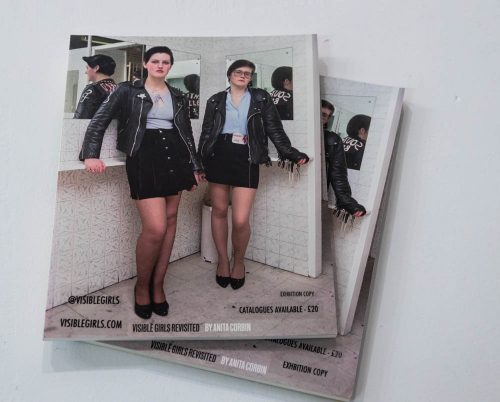 an adult, this new exhibition shows these now fifty-something women as strong, confident, and predominantly happy people. Corbin always talks to her subjects, and it is both interesting and invigorating to hear their stories and find out where each woman is now. Many women feel that age renders them invisible – they are not seen and their voices are not heard. Corbin shows that this does not have to be the case.
an adult, this new exhibition shows these now fifty-something women as strong, confident, and predominantly happy people. Corbin always talks to her subjects, and it is both interesting and invigorating to hear their stories and find out where each woman is now. Many women feel that age renders them invisible – they are not seen and their voices are not heard. Corbin shows that this does not have to be the case.
Anita Corbin also worked with the contributors to Invisible Spaces, a collaboration enjoyed as much by Corbin as by the young people themselves. We all need, says Corbin;
‘to wonder upon not just what it is that drives us to continually forge a visual connection to our past, but (also) how we can use what we see there to form a positive relationship with our present – and our future.’
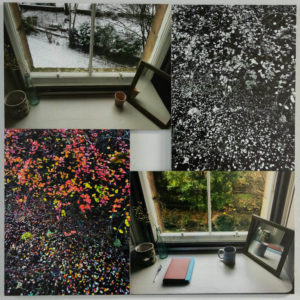 Invisible Spaces and Visible Girls: Revisited are at Summerhall , Summerhall Place, Edinburgh until 21 December 2018. Both exhibitions are open every day except Mondays.
Invisible Spaces and Visible Girls: Revisited are at Summerhall , Summerhall Place, Edinburgh until 21 December 2018. Both exhibitions are open every day except Mondays.
A programme of events, including workshops in screenprinting, photography and 8mm film, talks and street photography, will take place around the exhibitions. For details please contact Summerhall on 0131 560 1580 or pick up a leaflet at the venue.
Anita Corbin is still hoping to trace more of the women she photographed in 1981. You can contact the project by emailing found@visiblegirls.com or for more information click here: http://visiblegirls.com/
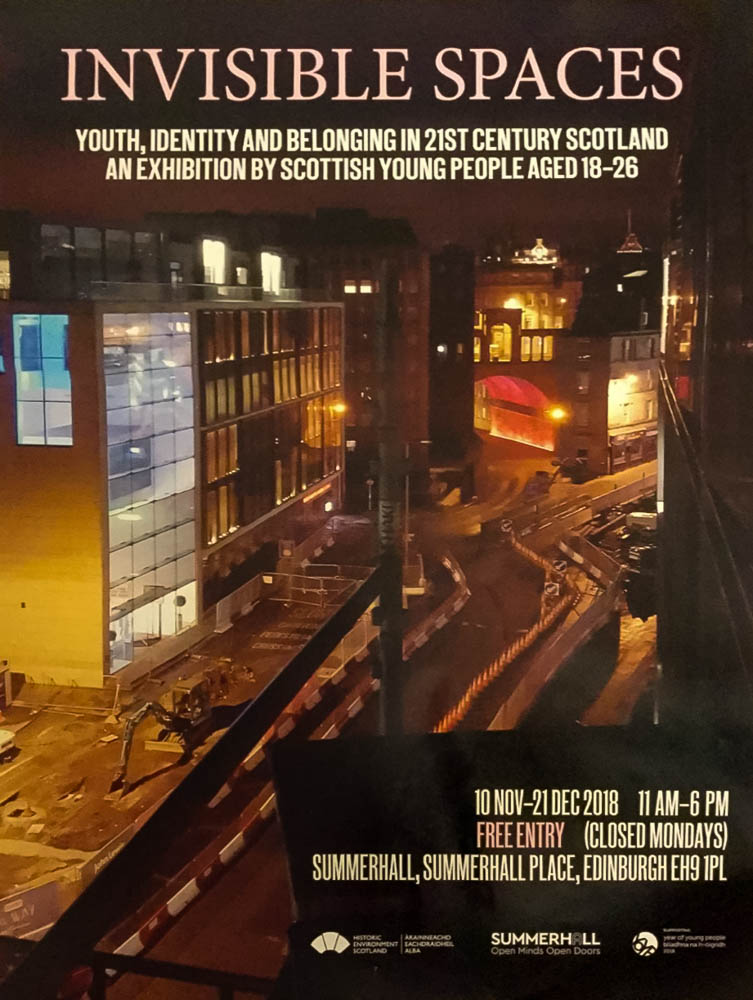
Historic Environment Scotland is the lead public body set up to investigate, care for and promote Scotland’s historic environment. In addition to its conservation, advisory, research and management roles, it offers a wide programme of events for all ages throughout the country. Visit https://www.historicenvironment.scot/ for more information.
